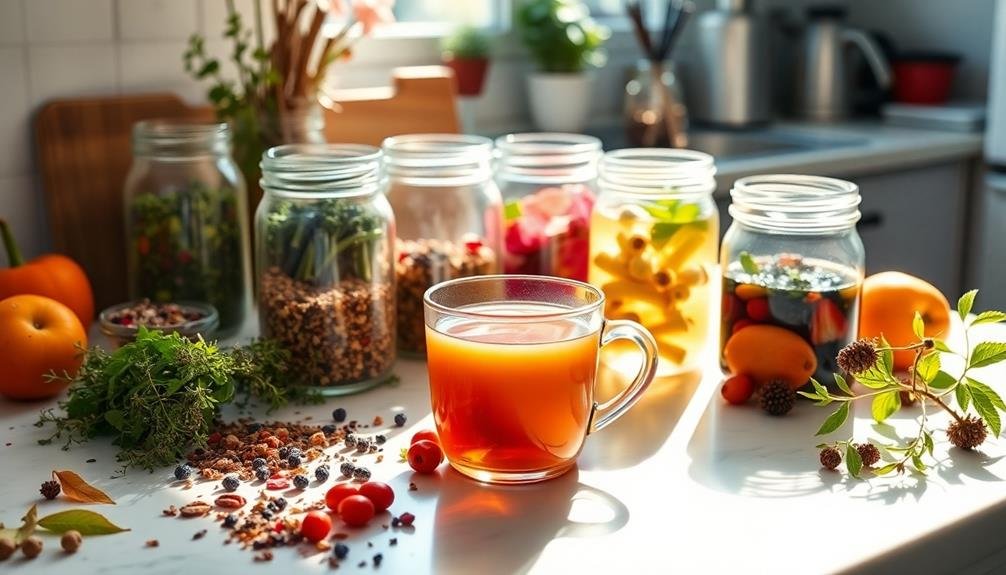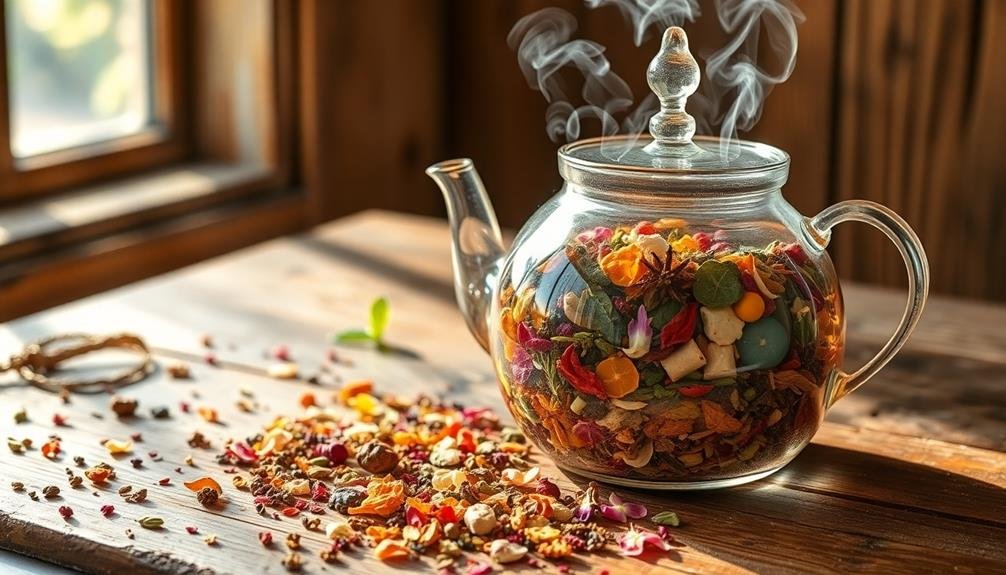Creating your own herbal tea blends offers numerous benefits tailored to your unique needs. You'll have complete control over ingredients, ensuring quality and avoiding unwanted additives. Custom blends allow you to target specific health concerns while personalizing flavors to suit your taste preferences. It's a cost-effective way to enjoy premium teas, as you can buy herbs in bulk and adjust serving sizes. You'll also have the opportunity to experiment with seasonal and local ingredients, fostering creativity and connecting with your environment. By crafting your own blends, you'll initiate a sensory journey of discovery and self-expression. The world of custom tea blending awaits your exploration.
Health Benefits of Custom Blends

With custom herbal tea blends, you're able to tailor your drink to target specific health concerns. By combining different herbs, you can create potent mixtures that address multiple issues simultaneously. For example, you might blend chamomile for relaxation, peppermint for digestion, and ginger for inflammation. This personalized approach allows you to maximize the potential health benefits of each herb.
Creating your own blends also guarantees you're using high-quality, fresh ingredients. You'll know exactly what's in your tea, avoiding artificial additives or preservatives often found in commercial blends. This control over ingredients can be particularly beneficial if you have allergies or sensitivities.
Custom blends let you adjust the strength and flavor to your liking, making it easier to incorporate beneficial herbs into your daily routine. You can experiment with different combinations to find what works best for your body and taste preferences.
Additionally, the act of blending and brewing your own tea can be a mindful, stress-reducing practice in itself. By taking an active role in your health through custom herbal tea blends, you're more likely to stick to a consistent wellness routine.
Personalized Flavors and Aromas
Beyond their health benefits, custom herbal tea blends offer a world of personalized flavors and aromas. By creating your own blends, you'll have the power to tailor your tea experience to your exact preferences. You can mix and match herbs, spices, and flowers to craft unique flavor profiles that suit your palate perfectly.
Start by exploring different base herbs like chamomile, peppermint, or rooibos. Then, add complementary flavors such as cinnamon, ginger, or lavender to create depth and complexity. Don't be afraid to experiment with unusual combinations – you might discover a new favorite blend!
Consider the aromatic qualities of your ingredients as well. Some herbs, like lemongrass or rose petals, can add delightful scents to your tea. These aromas can enhance your overall experience and even influence your mood.
As you become more familiar with various ingredients, you'll develop a keen sense of how different herbs interact. This knowledge will allow you to create seasonal blends, mood-specific teas, or even personalized gifts for friends and family.
Cost-Effective Tea Making

Creating your own herbal tea blends isn't just a way to customize flavors; it's also a cost-effective approach to enjoying high-quality teas. By purchasing herbs in bulk and mixing them yourself, you'll save money compared to buying pre-packaged specialty teas.
You'll also have control over the quality and freshness of your ingredients.
When you make your own blends, you can:
- Experiment with different ratios to find your perfect balance
- Adjust serving sizes to reduce waste
- Use locally sourced or homegrown herbs for even greater savings
- Create large batches of your favorite blends for long-term use
- Avoid paying for packaging and marketing costs associated with commercial teas
Control Over Ingredients
When you blend your own herbal teas, you're in complete control of what goes into your cup.
You can avoid unwanted additives often found in commercial blends and customize flavor profiles to suit your palate.
Avoid Unwanted Additives
Control over ingredients is a key advantage of making your own herbal tea blends. When you create your own mixtures, you can avoid unwanted additives often found in commercial teas. You'll know exactly what's in your cup, ensuring you're not consuming artificial flavors, preservatives, or hidden allergens.
By crafting your own blends, you can:
- Select organic herbs and spices
- Avoid artificial colorings and flavorings
- Eliminate unnecessary fillers or "natural flavors"
- Steer clear of added sugars or sweeteners
- Exclude potential allergens or sensitizers
You'll have complete control over the quality and origin of your ingredients. This means you can choose sustainably sourced, fair-trade, or locally grown herbs.
You'll also be able to adjust the proportions of each component to suit your taste preferences and health needs.
Creating your own blends allows you to experiment with unique combinations that aren't available commercially. You can tailor your teas to address specific health concerns or to achieve desired flavor profiles.
Customize Flavor Profiles
One of the most exciting aspects of blending your own herbal teas is the ability to customize flavor profiles. You're in complete control of the ingredients, allowing you to create unique combinations that cater to your specific taste preferences.
Start by selecting a base herb, such as chamomile or peppermint, then experiment with complementary flavors. Add a touch of sweetness with licorice root or stevia leaf, or introduce a citrusy note with lemongrass or orange peel.
You can adjust the strength of each ingredient to achieve the perfect balance. If you prefer a bolder taste, increase the proportion of stronger herbs. For a milder blend, use more subtle flavors.
Don't be afraid to mix unexpected combinations – you might discover a new favorite. Keep a record of your experiments to replicate successful blends and refine your recipes over time.
Adjust Ingredient Ratios
As you gain confidence in blending herbal teas, you'll discover the importance of adjusting ingredient ratios. This skill allows you to fine-tune your creations, ensuring each cup meets your exact preferences.
By experimenting with different proportions, you can emphasize certain flavors, aromas, or health benefits while balancing others.
Start by identifying your base ingredient, typically making up 50-60% of the blend. Then, add complementary herbs and flavors in smaller amounts.
Keep these points in mind when adjusting ratios:
- Strong-flavored herbs like peppermint or cinnamon should be used sparingly
- Mild herbs such as chamomile or lemon balm can be used in larger quantities
- Consider the therapeutic effects of each herb and adjust accordingly
- Balance flavors by combining sweet, bitter, and aromatic elements
- Use flowers and fruit pieces for visual appeal and subtle flavor enhancements
Seasonal and Local Adaptations

Versatility shines through in the world of herbal tea blends when it comes to seasonal and local adaptations. You can tailor your creations to match the changing seasons and use ingredients readily available in your area.
In spring, incorporate fresh, tender herbs like mint or lemon balm. Summer calls for cooling blends with hibiscus or lemongrass. As autumn arrives, switch to warming spices like cinnamon and ginger. Winter blends might feature immune-boosting herbs such as echinacea or elderberry.
Look to your local environment for inspiration. If you live near the coast, consider adding sea buckthorn or rosehips for a vitamin C boost. Mountain dwellers can forage for wild herbs like thyme or yarrow.
In urban areas, you might grow herbs on your balcony or source them from local markets. By adapting your blends to what's seasonally and locally available, you'll create unique teas that reflect your surroundings and support sustainable practices.
You'll also enjoy fresher ingredients with potentially higher potency. This approach allows you to connect with nature's rhythms and your local ecosystem while crafting personalized, health-supporting tea blends.
Creative Expression Through Tea
The art of blending herbal teas offers a unique canvas for creative expression. When you craft your own tea blends, you're not just mixing flavors; you're creating an experience. It's a chance to tell a story through taste, aroma, and visual appeal.
You'll discover that each herb brings its own character to the blend, allowing you to compose a symphony of flavors that reflect your personality and mood. Expressing yourself through tea blending can be deeply satisfying.
You'll find yourself:
- Experimenting with unexpected flavor combinations
- Crafting blends that evoke specific memories or emotions
- Designing visually stunning mixes with colorful herbs and flowers
- Tailoring blends to support your health and wellness goals
- Creating personalized gifts that convey thoughtfulness and care
As you explore deeper into the world of herbal tea blending, you'll develop a keen sense for how different ingredients interact. You'll learn to balance bold flavors with subtle notes, creating harmonious blends that delight the senses.
This creative process isn't just about the end product; it's about the journey of discovery and self-expression. By blending your own teas, you're not just making a beverage—you're crafting an extension of yourself.
Frequently Asked Questions
How Long Can Homemade Herbal Tea Blends Be Stored?
You can store your homemade herbal tea blends for up to a year if kept in airtight containers away from light, heat, and moisture. However, it's best to use them within 6 months for ideal freshness and flavor.
What Equipment Is Needed to Start Making Custom Tea Blends?
You'll need basic kitchen equipment to start blending teas. Get a digital scale, airtight containers, mixing bowls, and a mortar and pestle. Don't forget labels, a tea infuser, and quality ingredients. You're all set to create!
Are There Any Herbs That Shouldn't Be Mixed Together?
Yes, you shouldn't mix certain herbs. Be cautious with St. John's Wort, which interacts with many medications. Avoid combining sedative herbs like valerian and passionflower. Always research potential interactions before blending herbs to guarantee safety.
Can I Use Fresh Herbs Instead of Dried Ones?
Yes, you can use fresh herbs in your tea blends. They'll provide a more vibrant flavor, but you'll need to use more of them. Remember to wash fresh herbs thoroughly and adjust steeping times accordingly for the best results.
How Do I Determine the Right Proportions for My Tea Blend?
Start with a base herb, then add complementary flavors. You'll want to experiment with ratios, typically using 1-2 teaspoons per cup. Adjust to your taste preferences, considering strength and balance of flavors in your blend.
In Summary
You've discovered the joy of crafting your own herbal tea blends. You're now in control of your health, flavors, and costs. You've tailored your teas to your tastes and local ingredients. You're expressing your creativity through unique combinations. Whether you're seeking specific benefits or just enjoying the process, custom blending has opened up a world of possibilities. Keep experimenting, and you'll always have the perfect cup waiting for you.





Leave a Reply